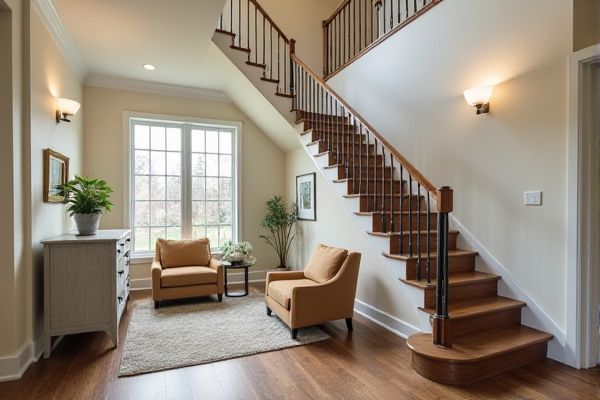
A quarter-turn staircase changes direction by 90 degrees, fitting neatly into tight spaces, while a half-turn staircase reverses direction by 180 degrees, offering a more spacious and elegant design. Discover which style best suits Your home's layout and aesthetic by reading the rest of this article.
Table of Comparison
| Feature | Quarter-Turn Staircase | Half-Turn Staircase |
|---|---|---|
| Design | Changes direction by 90 degrees | Changes direction by 180 degrees |
| Space Efficiency | Compact, fits in small spaces | More space required due to U-shape |
| Installation | Relatively simple | More complex due to landing |
| Safety | Good handrail support, reduced fall distance | Landing improves safety by providing rest area |
| Visual Appeal | Modern and sleek look | Traditional and robust appearance |
| Usage | Ideal for small homes and tight spaces | Common in multi-story buildings |
Introduction to Quarter-Turn and Half-Turn Staircases
Quarter-turn staircases feature a 90-degree turn, providing space-efficient navigation and a visually dynamic architectural element. Half-turn staircases incorporate a 180-degree turn, creating a compact U-shaped layout ideal for confined spaces and enhanced safety through landings. Both designs optimize floor plan utilization while offering distinct aesthetic and functional benefits.
Key Design Differences
Quarter-turn staircases change direction by 90 degrees with a single landing, creating a compact, L-shaped layout ideal for saving space. Half-turn staircases, also known as U-shaped, feature a 180-degree reversal with a landing between two straight flights, providing a more spacious and visually open design. Your choice between these depends on the available space, aesthetic preference, and functional flow within your home or building.
Space Requirements and Layout
Quarter-turn staircases require less floor space and fit efficiently into corners, making them ideal for compact layouts. Half-turn staircases occupy more room due to the 180-degree turn but offer a smoother transition between floors, often creating a spacious landing area. Choosing between the two depends on available floor space and desired traffic flow within the building design.
Aesthetic Appeal and Architectural Styles
Quarter-turn staircases offer a sleek, modern aesthetic that complements contemporary and minimalist architectural styles by creating a crisp, angular visual flow. Half-turn staircases, featuring a 180-degree turn, provide a grander, more traditional appearance often suited to classic and colonial designs, adding a sense of spaciousness and formality. Your choice depends on whether you prefer a compact, dynamic look or a more expansive, elegant staircase that serves as a focal point in your space.
Structural Considerations
Quarter-turn staircases require precise load distribution around a single 90-degree turn, often needing reinforced corner support for stability. Half-turn staircases involve a 180-degree turn, demanding robust central landing support to handle increased structural stress and ensure even weight transfer. Your choice impacts the complexity of framing and foundation requirements, influencing overall building integrity.
Safety Features and User Accessibility
Quarter-turn staircases enhance safety by incorporating landings that reduce fall risk and provide resting points, making them suitable for users with limited mobility. Their design allows for easier navigation and better handrail placement, improving overall accessibility. Half-turn staircases, with their 180-degree turn, offer similar safety benefits but may require more space and careful design to ensure adequate visibility and maneuverability for diverse users.
Cost Comparison and Material Choices
Quarter-turn staircases generally cost less than half-turn staircases due to their simpler design and reduced material requirements, making them a budget-friendly option. Half-turn staircases often require additional structural support and more complex materials, which can increase both labor and material expenses. Your choice should consider the balance between available space and budget, as quarter-turn models optimize cost efficiency while half-turn staircases offer enhanced design versatility with higher investment.
Installation Process and Timeframe
Quarter-turn staircases typically require less installation time due to their simpler L-shaped design, which involves a single 90-degree turn and fewer components. Half-turn staircases, featuring a U-shaped layout with a 180-degree turn, demand a more complex installation process involving additional structural support and precise alignment. Consequently, quarter-turn staircases can often be installed more quickly, while half-turn staircases may take longer due to their intricate design and increased labor requirements.
Pros and Cons of Quarter-Turn Staircases
Quarter-turn staircases offer space-saving designs ideal for compact areas, providing a natural landing that enhances safety and easy navigation. However, their complexity in construction can increase costs and require precise measurements to ensure smooth transitions between flights. While aesthetically versatile, quarter-turn stairs may limit furniture movement compared to straight or half-turn staircases, potentially challenging in tight spaces.
Pros and Cons of Half-Turn Staircases
Half-turn staircases offer space efficiency by changing direction 180 degrees, allowing better use of compact areas and improved safety with a mid-landing for resting. They provide enhanced visual appeal and are easier to navigate than continuous straight stairs but require more structural support and can complicate furniture movement between floors. The design flexibility accommodates various architectural styles, though installation costs and complexity are generally higher compared to quarter-turn staircases.
 homyna.com
homyna.com